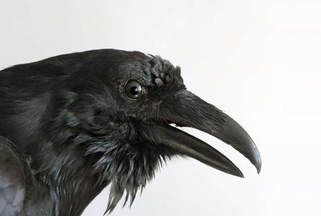 The other morning I was out watering when a raven landed on the compost heap and began “talking” to me. Naturally I replied. This raven wasn’t “quorking” but making other curious and complex sounds while staring directly into my eyes and the further we got into conversation the more fascinated/puzzled I became. S/he used so many vocalizations in response to whatever I was saying that I couldn’t keep track of them. This raven pointed his beak directly at me while speaking. Our mutual exchange ended when the raven flew off to join his mate, leaving me astonished. What had we been talking about? I would have given anything to have a tape of that dialogue! One curious note: ever since that conversation these same two ravens acknowledge me with a quork whenever they fly over the house. For anyone seriously interested in ravens I highly recommend Bernard Heinrich’s book “The Mind of the Raven.” This biologist has probably studied ravens more extensively than anyone on the planet. He believes they are the brightest avians of all. As a naturalist, and therefore a generalist, I have to say that I believe that all birds are equally intelligent, albeit in different ways, but Corvids including jays and crows do seem to have a curious edge in terms of problem solving. There are three species of ravens but in this article I will be talking about Corvus corax, the common raven, which is geographically and ecologically one of the most widespread naturally occurring birds in the world. The raven is distributed throughout major portions of North America, Europe, Asia, and North Africa, and in all terrestrial biomes except tropical rain forests. The typical adult common raven, the largest of the three, measures about two feet from the tip of its bill to the tip of its tail and is a luminous coal black. Highly gregarious, adaptable and resourceful, ravens roost and feed in pairs, or scattered flocks, sometimes numbering hundreds (or thousands) depending on the area. Typically, they migrate only short distances with a change of seasons or variability of food sources. They may welcome newcomers, inviting them to dine. They may “mob” a would-be predator or intruder to protect each other or nestlings/ fledglings. The young birds may play games including having a tug of war. For fun, they may also drop and catch objects in midflight or snitch and cache shiny and inedible objects in secret places or yank the tail of a would be predator. Opportunistic and omnivorous, the ravens and crows feed primarily on the most abundant food source available. This could include a broad range of insects, arachnids (e.g. spiders, scorpions), reptiles, small birds, small mammals, pilfered eggs, grains and fruits as well as carrion and human refuse. Throughout the year, the birds spend substantial time resting, preening, sunning and peering around at their surroundings. They may bathe in shallow waters, sprinklers and snow, preening extensively afterwards. Most fascinating to me is that ravens may post themselves near an ant bed, allowing the insects to crawl through their feathers, leaving a blanket of formic acid to protect them—a natural pesticide that eliminates parasites – and then they pick the ants off and eat them! In the spring, when breeding season arrives, raven pairs mate and bond for the year and perhaps for life. During courtship, the birds may preen each other’s head feathers and gently clasp each other’s bills. They may engage in acrobatic flight, showing off, trying to impress a prospective partner. After mating, a pair turns to homemaking, which often becomes a family affair, with two or three “helpers” – often progeny from the previous season’s hatch – contributing to the raising of the young. Typically, the birds build their nest on a solid platform such as the fork of a tree, or sometimes, in the case of the common raven, on a ledge or crack in a cliff face. After she finishes her nest, the female lays five or six generally oval-shaped greenish-colored eggs over a period of several days. While she takes primary responsibility for incubating her eggs, the male guards the nest from predators, feeds the female on her nest, and may even incubate the eggs for brief periods. After hatching the youngsters develop the ability to take care of themselves, but stay in the vicinity of the nest still begging their parents and the helpers for food. After a couple of months, they may leave to join other adolescents, but some may return the following year to serve their turn as helpers in raising their parents’ next brood. The next time you see a raven strike up a conversation and see what happens. Observing these birds as they go about their business of making a living is so much fun!
0 Comments
Your comment will be posted after it is approved.
Leave a Reply. |
Submit your ideas for local feature articles
Profiles Gardening Recipes Observations Birding Essays Hiking AuthorsYou! Archives
October 2025
Categories
All
|
 RSS Feed
RSS Feed